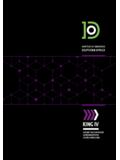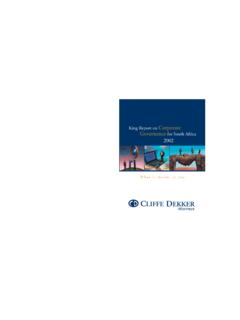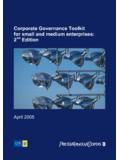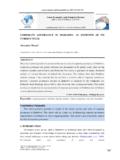Transcription of The National Cod e of Corporate Governance for Mauritius …
1 DefinitionsBoard The principal governing body of an charter A document that defines the Board s Governance role. Chief Executive Officer The person responsible for the conduct of the business of the organisation under the immediate authority of the Board of Control Objectives for Information and Related Technology (COBIT) is aframework created by ISACA for information technology (IT) management and IT Governance COBIT 5 was published in of ethics A document that defines an organization s values, responsibilities and ethical obligations. It provides guidance for handling difficult ethicalsituations related to the Governance A framework of processes and attitudes within an organisation that focuses on adding value to the business, ensuring its long-term continuity and success and building its Governance code A set of principles and recommendations aimed at improving and guiding the Governance practices of organisations within a Committee of Sponsoring Organisations of the Treadway A cross-directorship exists when two (or more) directors sit on the Boards of the Social Responsibility Corporate Social Responsibility is the concept whereby companies act to balance their own economic growth with the sustainable social andenvironmental development of the country.
2 A Company performinghighly in CSR is one that goes beyond compliance with the legalframework to actively pursue positive impacts on local communities and the director A member of the Board who is an employee of the of a category 1 A resident corporation licensed by the Financial Services Commission global business licence which conducts its business outside Mauritius , has at least 2 directors resident in Mauritius , of sufficient calibre to exercise independence of mind and judgment; maintains at all times its principal bank account in Mauritius ; keeps and maintains, at all times, its accounting records at its registered office in Mauritius ; prepares, or proposes to prepare its statutory financial statements and causes or proposes to have such financialstatements to be audited in auditing Internal auditing is an independent and objective assurance and consulting activity designed to add value and improve an organisation s helps an organisation accomplish its objectives by bringing a systematic,disciplined approach to the evaluation and improvement of risk management, control and Governance Companies Management Companies act as intermediaries between clients and the Financial Services Commission and operate under the Financial Services Commission Guidance Notes for Management Companies.
3 2 Non executive director A member of the Board who is not an executive director and who is not associated with the day-to-day activities of the public interest entity A public interest entity is currently defined as: All companies listed on the Stock Exchange of Mauritius All banks and nonbanking financial institutions Any Company which has, during 2 consecutive preceding years, at least one of the following: о an annual turnover exceeding 500 million rupees; or о total assets exceeding 500 million rupees. Any group Company which has, during 2 consecutive preceding years, at least one of the following:о an annual turnover exceeding 1 billion rupees; or о total assets exceeding 1 billion rupees. Risk appetite The level of risk needed to be taken to attain appropriate or sought after tolerance The acceptable level of variation relative to the achievement of a specific A scorecard is a quantitative tool to measure the level of observance of a code and/or a standard of Corporate Governance .
4 Shareholder The owner of share capital, including a registered shareholder and abeneficial owner. It also applies to the intermediaries and agents employed to assist shareholders in scrutinising Governance Any person or group that is affected by the affairs of the organisation. This may include the regulator, trade unions, employees, customers, suppliers and the local OF and the Corporate Governance Application and on Applying the Generic Guidance for Guidance for Stock Exchange Listed Guidance for Family Companies (unlisted)..42 Guidance for Statutory Guidance for Groups and Guidance for holders of a Category 1 Global Business Licence and Management 1: The Role of Relevant 2: Document Position Statutory Letter of Director 3: Scorecard for Governance Framework and Self 4: 5: published in October 2003, the code of Corporate Governance for Mauritius (the code ) is held in highrespondents from public interest entities had used the code in their accounting and auditing activities,past nine consecutive years, the Mo Ibrahim Foundation has recognised Mauritius as having thehighest standards of Corporate Governance in Africa, and the World Bank Group has commented favourably onthe code in its Governance evaluation of the country.
5 However, the code is now over 12 years old, and the majority of the respondents to the 2014 National Committee of Corporate Governance survey believed that the current code needed to be revised. Reasons for revisions include the need to align the code with new laws and guidelines ( , the Bank of Mauritius 2008 and the BAI and Bramer Bank collapses in 2015; and identify and apply international bestpractices. The purpose of Corporate Governance is to facilitate effective, entrepreneurial and prudent management that can deliver the long-term success of an organisation. Corporate Governance is therefore about what the Board of an organisation does and how it sets the values of the organisation. It is to be distinguished from the day-to-day operational management of the organisation by full-time executives. Although Corporate Governance can that focuses on long-term continuity and success to add value to the organisation and build its Governance are associated with increases in organisations operational effectiveness and sustainability,This code comprises a set of principles and guidance aimed at improving and guiding thegovernance practices of organisations within Mauritius .)
6 It forms part of a larger body of existing laws, rules, regulations, principles and best practices that include: Laws of Mauritius ( , the Companies Act, 2001) Regulations Listing rules ( , the Listing Rules for the Stock Exchange of Mauritius ) Standards, guidelines and Codes of best practice ( , the Bank of Mauritius Guidelines) Corporate rules and provisions ( , by laws) Formal documents within an organisation ( , Board charters) The code recognises that scandals arising from poor Governance that impact upon Public Interest Entitiesshould primarily be dealt with by legislation. This new code supplements the move to improve the Governance practices in Mauritius that is being led byMr Sudarshan Bhadain, , the Minister of Financial Services, Good Governance and Institutional an apply and explain methodology, this code aims to encourage high-quality Corporate Governance with inbuilt flexibility that allows organisations to adapt their practices to their particular circumstances.
7 It emphasises the need for Boards to focus on the effective performance of their key tasks. It is intended that the code will: Advance Corporate Governance reforms in both the public and private sectors in Mauritius by creating a Corporate Governance framework of principles for business leaders to apply. Encourage positive change amongst the Mauritian business community by focusing on improving the effectiveness of Governance practices. Provide maximum flexibility through a focus on principles rather than mandatory regulations and development of this new code was led by Dr Chris Pierce, a Governance expert with vast worldwideexperience in leading Governance reforms. In 2014, under the leadership of Tim Taylor, who was then the Chairperson of the National Committee of Corporate Governance , five task committees were set up. These committees provided oversight and advice to Dr Pierce during the consultations that involved questionnaires, meetings and interviews with key stakeholder individuals and groups.
8 I would like to record my thanks, appreciation and admiration to Dr Pierce, all of the National Committee members both past and present, the task committee members and all of the other individuals who were involved in the consultation process for their input indeveloping this am confident that this new code will have a significant impact upon the Governance practies in Mauritius . As the newly appointed Chairperson of the National Committee on Corporate Governance , I am lookingforward to the Committee overseeing the implementation of this new code . The Committee isalso committed to providing additional Governance advice and information on our website at LagesseChairperson of the National Committee on Corporate GovernanceNovember 2016 Governance AND THE code Principles-Based versus Rules-Based ApproachMauritius has a mature and well-developed legal system based primarily on rules. Codes are different to other parts of the legal system since they adopt a principles-based rather than a rules-based approach.
9 Aprinciples-based approach provides an organisation with the flexibility to adopt systems and procedures that suit its individual circumstances, but the organisation must then explain how it has applied each principles contained in this code have been formulated so that organisations report on how they haveapplied each principle. Our recommended approach for Corporate Governance depends heavily on disclosure of Corporate Governance practices by organisations. Implementing the principles necessarily includes reporting about Corporate Governance practices to shareholders and other stakeholders, and this can be achieved best onthe website and in the organisation s annual report. Apply-and-Explain As a result of extensive consultation, the code , as far as possible, avoids taking a mandatory or prescriptive approach to Governance practices that focus on compliance requirements A tick-the-box approach to governancereporting is not being recommended. Based on a philosophy of application coupled with disclosure, the code employs an apply-and-explain methodology.
10 The code of Corporate Governance for Mauritius is the first to adopt this new approach tocorporate Governance . This is a departure from the comply-or-explain approach associated with the Cadbury Report in the UK (1992) and the apply-or-explain approach associated with the Dutch Tabaksblat code of Corporate Governance (2004) and the King III Report in South Africa (2009). All public interest entities and other entities required to report on Corporate Governance are required to apply all the principles contained in the code and to explain in their annual reports how these principles have been applied. The law and the regulatory framework, however, take precedence over the code in any cases involving inconsistencies or than being a rigid set of rules, the code comprises eight principles on just two pages. The principles form the core of the code . Every Board of directors should decide how to apply each principle. The Board should focus on the annual report s explanation of how an entity has applied the principles.





